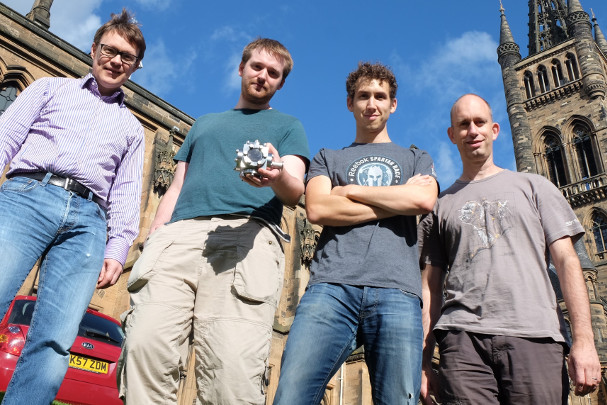
Drawn together: the team working together to build the world's first miniature gravity sensor. From left to right, Douglas Paul, Steven Bramsiepe (holding the prototype), Richard Middlemiss and Giles Hammond. Credit: Richard Middlemiss
How we're taking our great idea beyond the lab into the real world
20 September 2016

Richard Middlemiss
Drawn together: the team working together to build the world's first miniature gravity sensor. From left to right, Douglas Paul, Steven Bramsiepe (holding the prototype), Richard Middlemiss and Giles Hammond.
A Scottish scientist reflects on how his team built the world’s smallest gravity detector.
In December 2014, as my wife and I left for our honeymoon in Hawaii, I had no idea I was also about to take the biggest leap of my scientific career.
I was part of a team attempting to build the world’s first microelectromechanical (MEMS) gravimeter; a sensor the size of a postage stamp that could measure minute changes in gravity. These signals are sometimes observed before volcanic eruptions. An ultra-sensitive detector would be invaluable to early warning systems.
With hours to go before I left, my colleagues and I set up the experiment in a basement laboratory in the School of Physics and Astronomy at the University of Glasgow and left it to run.
Halfway through the holiday I sneaked a look at my emails. The first data had come in and the shape of the signal looked very familiar. We had just measured the Earth tides - a distortion of the Earth's crust caused by the gravitational pull of the Sun and Moon - a first with MEMS technology.
The MEMS gravimeter is a great example of a practical application spinning out of fundamental research. Without the expertise of the community of researchers seeking to detect gravitational waves, a field developed purely for the joy of gaining a deeper understanding of the Universe, the development of our device would not have been possible. Existing gravimeters cost tens of thousands of pounds, but MEMS devices can be produced cheaply – they are the technology used to create the accelerometers in your mobile phone. MEMS gravimeters have the potential to become a transformative technology. A huge wave of interest from industry came after our results were published in Nature.
Our experience also illustrates the benefits of working with colleagues outside your field. Our team formed four years ago after a conversation at a networking event between two University of Glasgow scientists; each a leader in their field.
Physicist Giles Hammond, from the Institute for Gravitational Research (IGR), was a key member of the collaboration that recently discovered gravitational waves. Hammond brought with him extensive knowledge of precision measurement and low noise optical sensors. Indeed, the geometry of the MEMS device was inspired by isolation systems used within some gravitational wave detectors, which have been described as the most sensitive machines ever built.
Douglas Paul, from the School of Engineering, is a leader in electronics at the nanoscale. At the time, he was also the director of the James Watt Nanofabrication Centre (JWNC), whose expertise is used by 12 of the top 20 semiconductor companies in the world. Paul was ideally placed to guide the fabrication of the MEMS devices. I joined the team when the pair had just enough money to cover the cost of my PhD. The success of our project has brought in more funds, and we are now a team of more than 10 researchers.
After demonstrating our technology, we knew its commercial potential was huge. We were quick to file a patent application. But, at this point we faced the complex path that many scientists confront when trying to commercialise their discovery. It would have been easy for our device to remain just an experiment in a university basement, many brilliant ideas have met a similar fate.
Fortunately, we had the help of QuantIC, a Glasgow University-led hub that exploits academic knowledge to create emerging technologies with the potential to benefit the UK economy. The hub encompasses seven universities and more than 30 industry partners. With the guidance of partner companies through QuantIC, we targeted our device with specifications that would make the technology most useful to industry. This way of thinking can be at odds with a traditional academic outlook – where cost and size may not be prioritised over ultimate accuracy.
The close proximity of the IGR, the JWNC and QuantIC also meant we could make quick progress with our technology. The end result is sensors that are small enough to be flown in drones for aerial surveys and cheap and sensitive enough to create gravimeter networks that can monitor volcanoes or detect oil reservoirs. Next week we start field trials.
Watching the MEMS gravimeter progress from a blank page to its current state has been an incredibly rewarding experience. I am now a research assistant on the project, and I hope the next four years will be as exciting as the last four.
